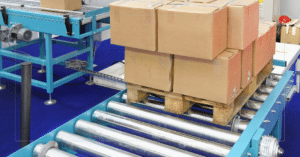Palletizing plays a crucial role in packaging, logistics, and warehousing. But like any industrial process, things can occasionally go wrong, requiring immediate attention. Whether you’re managing a busy warehouse or working on a production line, knowing the right emergency procedures can prevent injuries, avoid product loss, and keep operations running smoothly.
Why are Emergency Procedures Important?
Unexpected events happen, even in well-organized environments. Emergency situations like equipment breakdowns, pallet collapses, or personnel injuries can bring operations to a halt. However, with a solid emergency plan in place, you can:
- Minimize injuries by acting quickly and correctly.
- Reduce product loss through timely intervention.
- Keep downtime to a minimum by addressing the problem efficiently.
- Promote a safe workplace by empowering employees to respond confidently.
Emergency Procedures in Palletizing
Palletizing involves stacking products on pallets for storage or shipping. This process can be manual or automated, depending on the facility. While it sounds straightforward, handling heavy loads, machinery, and different materials introduces risks like pallet collapses, equipment malfunctions, and injuries. That’s why having emergency procedures in place is critical.
The following types of emergencies you might face and the practical steps you can take to handle them.
1. Equipment Breakdown
Automated palletizing equipment makes work faster, but what happens if the machine malfunctions mid-shift? Equipment breakdowns are among the most common emergencies in palletizing operations, and they can bring everything to a standstill.
What to Do:
- Stop the machine immediately: If something seems off, press the emergency stop button to prevent further damage or injury.
- Notify the supervisor: Report the issue to the line manager or technician.
- Follow lockout/tagout (LOTO) procedures: This ensures no one can accidentally restart the machine while it’s being inspected.
- Inspect for obvious causes: Check for loose wires, blocked conveyors, or items stuck in the system.
- Contact maintenance: If the problem isn’t immediately solvable, escalate it to your technical team for repair.
2. Pallet Collapse or Product Damage
A poorly stacked pallet can collapse during handling or transit, potentially injuring workers and damaging products. Pallet collapses are not only dangerous but also expensive, especially if they involve high-value items.
What to Do:
- Secure the area: Clear the surrounding area to prevent further accidents.
- Assess for injuries: Check if anyone was hurt and administer first aid if necessary.
- Report the incident: Inform the supervisor about the collapse.
- Separate salvageable products: If products are damaged, set aside the usable ones to reduce losses.
- Identify the cause: Look for signs of improper stacking, uneven weight distribution, or damaged pallets.
- Restack with caution: Follow proper stacking techniques, ensuring heavy items are at the bottom and lighter ones on top.
3. Worker Injury or Medical Emergency
Despite safety measures, accidents can happen. Whether it’s a slip, trip, or machine-related injury, knowing how to respond to a medical emergency is essential.
What to Do:
- Stop work immediately: Make sure the injured worker is out of harm’s way.
- Provide first aid: If trained, administer basic first aid. Call for professional medical help if needed.
- Alert the supervisor: Report the injury to ensure appropriate action is taken.
- Document the incident: Accurate records help identify causes and prevent future accidents.
- Follow up with the worker: Ensure they receive the necessary medical attention and support.
4. Fire or Electrical Issues
In industrial settings, fires and electrical issues can be catastrophic if not handled properly. Palletizing areas often have flammable materials (such as cardboard packaging), making it crucial to act fast during a fire or electrical emergency.
What to Do:
- Activate the fire alarm: Evacuate everyone if there’s a fire or smoke detected.
- Use fire extinguishers: If trained and it’s safe, use an extinguisher to put out small fires.
- Shut down electrical equipment: If the fire is electrical in nature, turn off the power supply if it’s safe to do so.
- Evacuate the area: Ensure all workers follow evacuation routes and gather at the assembly point.
- Contact emergency services: Call local fire services for immediate assistance.
5. Blocked Conveyor Belt or Jams
In palletizing operations, conveyor belts keep everything moving. But when a belt gets blocked or jammed, it can cause bottlenecks, resulting in downtime and frustration.
What to Do:
- Press the emergency stop button: Stop the conveyor to prevent further jams.
- Identify the blockage: Look for items that may have caused the jam, such as misaligned products or debris.
- Remove the blockage: If it’s safe, remove the object causing the issue.
- Inspect the belt: Check for any damage or wear and tear that could lead to future jams.
- Restart with caution: Once the blockage is cleared, start the conveyor slowly to ensure it runs smoothly.
6. Handling Hazardous Materials Spills
Some palletizing operations involve handling hazardous materials, such as chemicals or perishable goods. In the event of a spill, quick action is essential to protect workers and prevent contamination.
What to Do:
- Evacuate the area: Make sure everyone stays clear of the spill.
- Use protective equipment: Wear gloves, masks, or other protective gear when handling hazardous materials.
- Contain the spill: Use absorbent materials or barriers to prevent the spread.
- Follow spill control procedures: Dispose of hazardous materials according to safety guidelines.
- Report the incident: Notify the safety team to ensure proper documentation and cleanup.
Step-by-Step Emergency Action Plan
To ensure everyone knows what to do in an emergency, it’s essential to have a clear action plan.
- Emergency Stop Procedures: Train workers to use emergency stop buttons on equipment.
- Communication Protocols: Establish a chain of command for reporting emergencies.
- Evacuation Plans: Ensure everyone knows evacuation routes and assembly points.
- First Aid Training: Provide basic first aid training to key personnel.
- Routine Drills: Conduct fire and safety drills to reinforce emergency procedures.
- Incident Documentation: Keep a log of all incidents to analyze and improve safety practices.
Preventing Emergencies: Best Practices
While emergencies can’t always be predicted, many can be prevented through proper planning and maintenance.
- Regular Equipment Inspections: Schedule routine checks to catch potential issues early.
- Training and Awareness: Ensure all workers are trained in safety procedures and equipment handling.
- Proper Stacking Techniques: Teach workers to stack pallets evenly and securely to avoid collapses.
- Clear Workspaces: Keep aisles and work areas free from clutter to prevent trips and falls.
- Monitor Hazardous Materials: Store and handle dangerous materials according to regulations.
Conclusion
Emergencies in palletizing operations can happen when you least expect them, but with the right procedures in place, you’ll be ready to respond effectively. Whether it’s a machine breakdown, product spill, or worker injury, taking prompt and correct action will keep your team safe and minimize disruptions. Train your staff, conduct regular drills, and make safety a priority every day. Emergencies might be unavoidable, but being prepared will make all the difference.
AFA Systems Ltd. specializes in providing engineered packaging automation solutions, including cartoners, case packers, palletizers, and integrated systems for end-of-line packaging. We offer custom automation systems tailored to meet unique customer requirements, ensuring high efficiency and return on investment. AFA’s expertise lies in designing innovative machinery that enhances production line performance, a trusted partner in the packaging industry. Our comprehensive services include engineering evaluations, machinery rebuilds, and certified training, aimed at delivering effective and competitive packaging solutions. For more, visit AFA Systems.





